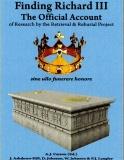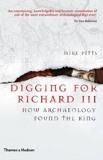Book Review: Finding Richard III – The Official Account
We thank Barbara for making her review of this book available to us.
Finding Richard III : The Official Account
of Research by the Retrieval & Reburial Project
 The Looking for Richard Project team, specifically Philippa Langley (the inaugurator) , John Ashdown-Hill BA, MA, PhD, FSA, FRHistS, Annette Carson, David Johnson BA Hons, MA, PhD, and Wendy Johnson, set out to discover the burial place and human remains of Richard III himself, although these were long considered lost forever. This, the official account, is a clear, precise and riveting summary of facts, not of opinions. However, step by inspired step, we are led past the opinions of many as we follow the unique development of one of the most impressive and amazing archaeological discoveries ever achieved in England.
The Looking for Richard Project team, specifically Philippa Langley (the inaugurator) , John Ashdown-Hill BA, MA, PhD, FSA, FRHistS, Annette Carson, David Johnson BA Hons, MA, PhD, and Wendy Johnson, set out to discover the burial place and human remains of Richard III himself, although these were long considered lost forever. This, the official account, is a clear, precise and riveting summary of facts, not of opinions. However, step by inspired step, we are led past the opinions of many as we follow the unique development of one of the most impressive and amazing archaeological discoveries ever achieved in England.
In early 2009, Philippa Langley launched the search for Richard III’s resting place. She and the team then worked together to meticulously discredit the long held rumour of the desecration of his grave and the tossing of his remains into the River Soar, even though this unsubstantiated rumour was frequently upheld by others, even historians. There have also been years of mistaken belief as to the site of the Greyfriars Priory, considered the probable place of original burial in 1485. Many historical errors and later misjudgements were now researched and carefully corrected by the team, all briefly summarised here. With lucid and detailed explanation, this books covers every aspect, matching medieval probabilities to modern specifics until gradually we feel we have travelled the same journey, walked those 15th century streets, peered into those shadowed mysteries and so can share the team’s inspirational optimism.
With enormous expertise and determination, the team persisted until 2012 when at last, with council permission obtained, funds raised (principally from the Richard III Society) and legal agreements made with the relevant authorities, ULAS (University of Leicester Archaeological Services), were contracted and paid in advance accordingly as demanded, to undertake the digging in the area specified by the Project. Indeed, ULAS had so little belief in the probability of discovering Richard III’s actual remains, that they accepted the commission only when the wording of the contract was amended to specify and limit the dig to the excavation of the Franciscan Priory Church. Philippa Langley then insisted that contractual obligations include provision for the possible exhumation of human remains. The Looking For Richard team’s accuracy was so impressive to seem virtually unbelievable, so even after the leg bones of an adult male were discovered in the designated area on the very first day of the dig, ULAS could not believe they had begun to uncover Richard III himself.
Included in the narrative are the surprising disappointments and the failures of some, in particular the areas where original contractual agreements have not been met by other parties. For instance, the shocking failure of the university to invite John Ashdown-Hill to the official announcement of Richard III’s DNA match, which identified his remains beyond reasonable doubt, even though it was Mr. Ashdown-Hill alone who traced the living descendent used to conclude that DNA match, and Ms. Langley was only invited to speak after the TV coverage had ended. It is also evidently of some concern and against the wording of the original contract, for the remains of this anointed monarch and ancestor of the queen to still be retained by the university instead of having been laid to rest in some prayerful and respectful place until the re-interment process can be conducted. Difficulties with the Cathedral administration are also recorded.
But there is no winter of discontent here, no list of complaints or failures. Indeed, the book is a celebration of a rare and glorious success, leading to a greater knowledge and understanding of this long misunderstood and maligned king, and eventually to a fitting reburial.
Written with impressive clarity and extensive footnotes, without unacademic or emotional emphasis, this short book explains exactly what happened from initiation to conclusion. It is the summary of the search itself, and includes a full list of those who donated to the costs and copies of all the contracts involved. The considerable respect and care shown by Ms. Langley for the legal drafting of the original contractual agreements is precise and impressive. Whether her wishes have been fully complied with since, is another matter.
Although such facts can, as would be expected, seem dry at times, there is not one moment when this book becomes heavy, or can be even momentarily discarded. It is both a fascinating and rewarding read from beginning to end. And FINDING RICHARD III: THE OFFICIAL ACCOUNT covers one more necessary task, that of explaining exactly how the search not only originated with the Finding Richard Project, but was successful owing to their incredible expertise and persistence. In the face of repeated claims and assumptions that Leicester University or ULAS discovered Richard III’s burial place and his remains, it was instead the studious research and ultimate success of The Finding Richard Project, who have now produced this official account to set the record straight.
Tags: Books, Leicester Greyfriars Dig, Richard III
 Richard III was buried in the choir of the church of the Grey Friars in Leicester. Polydore Vergil states that the burial was “without any pompe or solemn funeral”. This is often – mistakenly – seen to indicate that there were no religious rites. However, as John Ashdown-Hill explains, “solemnity” in the religious context refers to certain aspects of a service, which were not essential. It basically means that the service was a private ceremony by the friars, especially as a choir of their church would not have been open to the public.
Richard III was buried in the choir of the church of the Grey Friars in Leicester. Polydore Vergil states that the burial was “without any pompe or solemn funeral”. This is often – mistakenly – seen to indicate that there were no religious rites. However, as John Ashdown-Hill explains, “solemnity” in the religious context refers to certain aspects of a service, which were not essential. It basically means that the service was a private ceremony by the friars, especially as a choir of their church would not have been open to the public.




